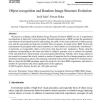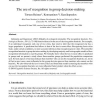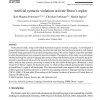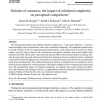COGSCI
2004
13 years 9 months ago
2004
A central issue in bilingual research concerns the extent to which linguistic representations in the two languages are processed independently of each other. This paper reports th...
COGSCI
2004
13 years 9 months ago
2004
We present a technique called Random Image Structure Evolution (RISE) for use in experimental investigations of high-level visual perception. Potential applications of RISE includ...
COGSCI
2004
13 years 9 months ago
2004
This article presents a review of reverse correlation in neurophysiology. We discuss the basis of reverse correlation in linear transducers and in spiking neurons. The application...
COGSCI
2004
13 years 9 months ago
2004
Goldstein and Gigerenzer (2002) [Models of ecological rationality: The recognition heuristic. Psychological Review, 109 (1), 75
COGSCI
2004
13 years 9 months ago
2004
In the present study, using event-related functional magnetic resonance imaging, we investigated a group of participants on a grammaticality classification task after they had bee...
COGSCI
2004
13 years 9 months ago
2004
This study investigated the roles of problem structure and strategy use in problem encoding. Fourthgrade students solved and explained a set of typical addition problems (e.g., 5 ...
COGSCI
2004
13 years 9 months ago
2004
When we look at a face, we readily perceive that person's gender, expression, identity, age, and attractiveness. Perceivers as well as scientists have hitherto had little suc...
COGSCI
2004
13 years 9 months ago
2004
The fundamental relations that underlie cognitive comparisons--"same" and "different"--can be demultiple levels of abstraction, which vary in relational comple...
COGSCI
2004
13 years 9 months ago
2004
In order to investigate whether addressees can make immediate use of speaker-based constraints during reference resolution, participant addressees' eye movements were monitor...
COGSCI
2004
13 years 9 months ago
2004
A feature is central to a concept to the extent that other features depend on it. Four studies tested the hypothesis that people will project a feature from a base concept to a ta...




